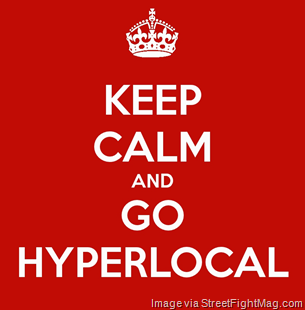 Even though the world is getting smaller, due to easy global connectivity, people still feel alone if not well-connected locally. There is also more going on in every location, so this personal need and super sensitivity to the local community has spawned a new breed of Internet startups, called “hyperlocal.” The term first appeared at least five years ago, but the model is now very common.
Even though the world is getting smaller, due to easy global connectivity, people still feel alone if not well-connected locally. There is also more going on in every location, so this personal need and super sensitivity to the local community has spawned a new breed of Internet startups, called “hyperlocal.” The term first appeared at least five years ago, but the model is now very common.
At first this was limited to news sites that concentrated on a segment of a community, like West Seattle, but the concept is now being applied to advertising and promotion sites, blogging sites, and even legal services sites. These hyperlocal sites don’t have to compete with global sites, and always have unique content, community advertising, and local issues.
Foursquare is good example of a modern hyperlocal site, which describes itself as “50% friend-finder, 30% social city guide, 20% nightlife game.” It also shows how such a website can scale by adding new cities. When you enter one of these cities, you simply check-in to tell the service where you are, and you begin to earn points and unlock badges for discovering new things.
Much of this is still evolving, and I think it has great potential. Yet there are big challenges to hyperlocal, at least for consumer-focused hyperlocal startups, according to Sean Barkulis, Founder of UPlanMe one of the early casualties in this space:
- Every site requires real curated local content to engage users. Building content is costly and time-consuming. If you don’t engage your users with an abundance of content the moment they open the app, odds are they will never return.
- Local businesses won’t use a site until it has a critical mass of users. This is the old chicken-and-egg problem. Without users, business owners aren’t going to waste time promoting and marketing their content to your users. Getting these users costs money.
- The burden of proof is on you to show value. In order for local businesses to buy in, they need to a) reach a large percentage of their customer demographic, b) save them time on their existing marketing efforts, and c) not duplicate any of their existing efforts.
- Expanding city-by-city is expensive. What’s more difficult than building one successful startup? Try building 50 successful startups. This is essentially what you are doing when you try to launch city-by-city. Finding common elements for scaling is tough
- The site may need consumer revenue to survive. It is possible to build a successful site that has components of #1, #2 and #3, but some good product or service right from the beginning helps viability. Maybe it’s selling local tours and taking a cut of the revenue.
- Watch out for local sales force requirements. Look at how large Groupon and Living Social’s sales forces are, and they are still struggling to maintain profitability. If the sales force is too large, the site will probably not prosper. Look for new ways to sell.
- Local business price points have to be low. Many of the customers in this space tell me that the figure is somewhere around $300 per year for their own internal break-even. They get many offers every month, so your entry offer better be low and convincing
- Funding requirements are substantial. Word-of-mouth and cheap viral marketing won’t build critical masses of users, curated content, and direct sales forces. Foursquare has raised more than $112 million in outside funding, on $2 million in revenue in 2012.
Barkulis and I agree that your hyperlocal startup has a far better chance if you position it as a B2B and B2B2C startup, like Yext, Locu, and Yodle. Then you are building a solution for local businesses that helps them regardless of a direct consumer base. The site must either save businesses time on their marketing efforts, or solve a direct problem they are having.
I predict that hyperlocal services sites will continue to emerge and evolve. Many years ago, a community law firm could have a rewarding law practice, financially and personally fulfilling, by becoming a part of the community. In the new digital age, it’s possible again, even easier and faster.
With the advent of the iPhone and Blackberry, location-based apps are becoming a part of this hyperlocal picture. Especially in local communities, people want to know where the sales are, and who is hanging out where. This is not just a fad.

